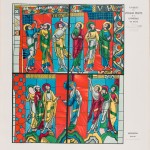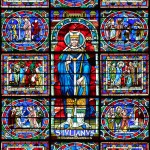The city of Le Mans is in the Loire region of France, 300 miles southwest of Paris. Le Mans is an ancient town with Roman walls, the seat of a Roman Catholic diocese, and is famous for its 24-hour sports car race. It is also home to the Cathédrale St.-Julien de Mans, which is one of the largest cathedrals in France and features a very rich collection of medieval stained glass.
Historians can date the cathedral’s first structure to the 9th century, with construction and rebuilding through the 15th century. Rebuilt after an 1134 fire, the restored cathedral was consecrated in 1158. The cathedral’s architecture combines a Romanesque basilica nave and High Gothic choir. The floor plan is illustrated here:

Plan of Le Mans cathedral (source)
Some of the cathedral’s older windows include:
- The Ascension window (plate 1), located in the nave aisle and dated by scholar Louis Grodecki to the period 1134-1158. It is one of the oldest extant stained glass windows in France.
- The great western window, with scenes from the life of St. Julian of Le Mans (ca. 1155).
- Many of the windows in the choir, from the 13th century, are scenes from the Old and New Testaments, the lives of saints, and miracles of the Virgin. Unfortunately, many of the windows in the radiating chapels are no longer in their original location.
The workshop that made the original windows is not known.
- The Ascension window in Le Mans Cathedral (plate 1, CMGL 138207)
- Stained glass depicting Julian of Le Mans – Le Mans Cathedral – Le Mans (Sarthe, France). By Selbymay (Own work) [CC BY-SA 3.0], via Wikimedia Commons
In the mid-19th century, a revival of interest in stained glass brought German and English stained glass artists and restorers to Le Mans with the purpose of restoring the cathedral’s windows. One of the Germans was Louis Steinheil, who restored the chapel of the Virgin in Le Mans in 1858. Watercolors for restoration of the cathedral’s windows still exist, some signed by Steinheil and some by an assistant named Weber. Also during the 19th century, there was a flourishing of publications on the craft of stained glass written by historians and artists, and the Order of Carmelites founded an atelier (or workshop) to promote the craft.
Eugene Hucher, a 19th century historian and numismatist, was the director of the Carmelite workshop as well as the director of the museum in Le Mans. In anticipation of the restoration of the cathedral’s windows, Hucher decided that there should be exact documentation of the early windows, allowing artisans to study the style, colors, and artistry of the original windows. The resulting folio, Calques des vitraux peints de la Cathédrale du Mans (1864), provides an important record of medieval iconography. A team under the cathedral’s renovation architect created tracings (Calques); the tracings were then printed in reduced format by the printer Monnoyer and hand painted in color by a member of the Carmelites’ atelier (Musées du Mans, p. 138).
Hucher’s folio highlights the cathedral’s windows from the 11th, 12th, and 13th centuries. In his forward, he mentions that the folio will include exact specimens of these windows so that contemporary (19th-century) artists could study the original windows they were restoring or recreating. The folio’s 100 plates provide incredible color recreations of the Ascension window, the Jesse Tree window, and the rose window, as well as the windows in the Virgin Chapel, the nave (Saint Julien), the choir, and the clerestory. The plates were issued in 10 annual fascicules (or parts), from 1854 to 1864.
In 2014, The Rakow Library acquired this very large volume. Its height (87 cm, or roughly 34 inches) makes it one of our “tallest” books; its dimensions require it to be stored flat on a large shelf. Scholar Meredith Parsons Lillich describes this book as “one of the pioneer glass studies of the nineteenth century”, and an “elephantine monograph” (Art Bulletin 1983). Our copy’s binding has the name J. Weber 1867 on its spine; he is presumably the owner of the volume when the fascicules were bound into one volume, and possibly Louis Steinheil’s assistant. (Hayward, p. 41).
The Rakow Research Library is open to the public 9 am to 5 pm every day. We encourage everyone to explore our collections in person or online. If you have questions or need help with your research, please use our Ask a Glass Question service.




1 comment » Write a comment